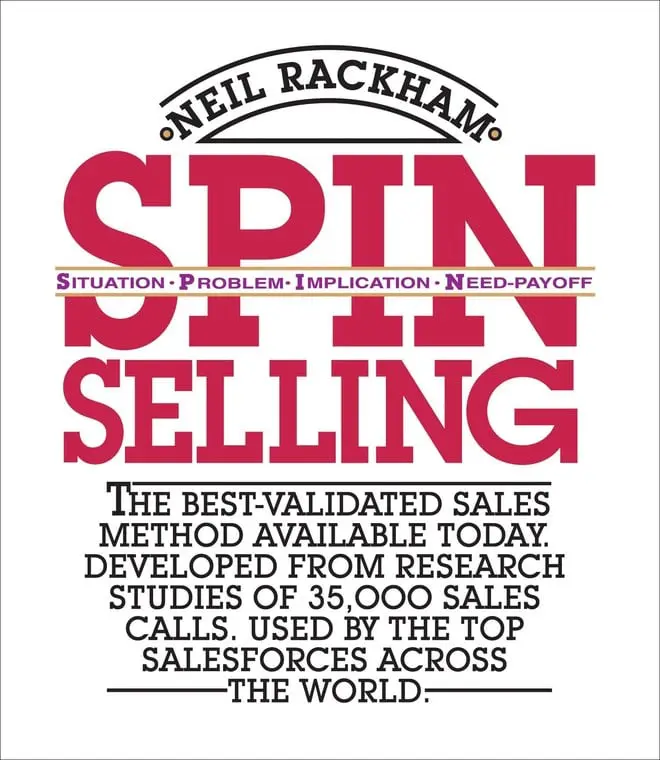1970年代にニール・ラッカムによって考案され、1988年に初めて書籍として出版されたSPINセリングは、最も古く、最もよく知られたセールスフレームワークの一つである。その古さにもかかわらず、今日の営業環境においても依然として妥当性を保っている。IBMやゼロックスなど、35,000件以上のセールスコールの広範な調査と分析に基づき、営業プロセスに組み込むべき4種類の質問を提示している。
ラッカムのSPINセールスのアプローチで重要なのは、組織の上層部との関わりを重視していることだ。これは一見簡単なことのように思えるが、企業の下層部の人間を選び、上層部に売り込ませる必要があると感じている人がいかに多いかは驚くべきことである。
SPINでは、重要な購買や投資に関する意思決定は、多くの場合、上層部で行われるため、戦略的な視点が重視される。上層部をターゲットにすることで、営業チームは購買決定に真に影響を与える懸念事項や優先事項に対処することができる。上層部に働きかけるのは難しいが、意思決定者にたどり着くには多くのお役所仕事を切り抜ける必要がある。

SPINセリングの定義
SPINの質問フレームワークは、潜在的な顧客との会話を導き、解決策を提案する前にニーズを掘り起こし、発展させるように設計されている。顧客との信頼関係を築き、可能な限り多くの情報を共有してもらうためだ。そして、この掘り起こされた情報は、顧客の問題を解決するためのすべての武器と正当な理由を営業に提供する。 SPINとは、4種類の質問の頭文字をとったものである:シチュエーションに関する質問
これらの質問は、営業担当者が顧客の現在の状況について背景情報を収集するのに役立つ。顧客の現在のプロセス、ツール、一般的なビジネス環境についての質問も含まれます。- 顧客との関係を管理するための現在のワークフローについて教えてください。
- 現在のプロセスについて教えてください。
問題質問
状況を理解した後、これらの質問は、顧客が経験している具体的な困難、問題、または不満を特定することを目的としています。これらの問題を特定することで、営業担当者は顧客のニーズにより適したソリューションを提供することができる。- 現在の顧客関係管理システムにどのような課題を感じていますか?
- プロセスのどの部分に改善の余地があると感じますか?
インプリケーションの質問
これらの質問は、顧客が特定された問題の結果と意味を理解するのを助ける、より深い質問である。問題の重要性と緊急性を増幅させ、解決策の必要性をより明確にするために使用されます。- こうした課題は、チームの生産性や顧客満足度にどのような影響を与えるのだろうか。
- もし[問題]が解決しない場合、あなたのビジネスの長期目標や日常業務にどのような影響がありますか?

ニーズ・ペイオフに関する質問
最後に、このような質問によって、顧客は自分の問題に対する解決策を見つけることのメリットや価値を考えるようになる。どのように状況が改善されるのか、それがビジネスにとってどのような意味を持つのか、顧客に考えさせることで、効果的に顧客自身が製品やサービスの必要性を正当化するように導くのだ。
- 具体的な問題]を解決することで、今後1年間でどのようなコスト削減を実現できる可能性がありますか?
- 問題の側面]を改善することで、顧客満足度や顧客維持率にどのような影響があると思いますか?
これらの質問には無限の言い方があるが、ラッカムの著作は、どのように質問を始めなければならないかについて、驚くほど明確である。
彼らは...
- オープンエンドの質問であること - 質問は「はい」か「いいえ」で答えられないようにすること。
- 会話を独占しない- 営業における間の力は万国共通である。担当者は質問もしなければならないが、積極的に聞くことも必要だ。
- 一度の電話でできるだけ多くの情報を得たいと思うかもしれないが、尋問されていると感じると、見込み客を疲れさせてしまう可能性がある。
- 実践的であること-セールスコールの前の準備が重要である。MRがどのように会話を進めたいかというフレームワークを用意しておくことを提案することで、適切な質問をし、必要な情報を得つつ、軌道に乗るようにすることができる。
SPINセールス・プロセス
通常、質問はSPINセールスの世界の主役であるが、ラッカムはSPINを使用する際の全体的なセールスプロセスのあり方についてもガイドラインを提示している。これは1回の電話で実施することもできるが、推奨されるものではないので、何回かに分けて会話する必要がある。
質問と同様、プロセスは4つのセクションに分かれている。
- 前座またはオープニング
- 調査中
- 能力の実証
- コミットメントの獲得
予備知識
セールス・サイクルの最初の段階では、製品の詳細を急いで説明しないことが重要だ。その代わりに、見込み客の興味をそそるような洞察に満ちた観察や質問で、見込み客を惹きつけることに重点を置くべきである。この段階は、親密な関係を築き、有意義なやりとりの舞台を整えることなのだ。
調査中
そこで、チームとMRは調査ジャーナリストの帽子をかぶるべきである。営業担当者は、入念な質問を通じて顧客の主要なニーズと課題を明らかにする必要がある。この理解によって、営業担当者は顧客の具体的な要件や意思決定要因に直接対応するように売り込みを調整することができる。
能力の実証
顧客のニーズを特定した後、営業担当者は自社の製品やサービスをこれらのニーズに効果的に結びつけなければならない。これには以下が含まれる:
特徴
製品の基本属性(例:「当社のプラットフォームは、営業電話や会議の多言語での書き起こしや要約を提供します。)
メリット
これらの機能の実用的なアプリケーション(例:「この機能により、すべての対話の重要な詳細とアクションアイテムが正確にキャプチャされるため、チームは録音をすべて見直すことなく、セールスコールの重要なポイントを確認することができます。)
メリット
これらの機能によって提供される究極の価値(例えば、「当社のツールを使用することで、営業チームはフォローアップを合理化し、アップセルの機会を迅速に特定することができます。これにより、最終的に時間を節約し、御社の全体的な生産性を高めることができます。salesforce.")
コミットメントの獲得
SPINジャーニーの最後のステップは、顧客が持つかもしれない躊躇や反対を克服することである。このような反対は、製品の価値や効果に関連していることが多い。詳細な暗示とベネフィットの議論を通じて、先手を打ってこれらに対処することで、営業担当者は抵抗を大幅に減らし、合意を促進することができる。
例えば、見込み顧客が、大規模な営業チームが開催する大量のミーティングを当社のツールでサポートできるかどうかを懸念している場合、営業担当者はプラットフォームのスケーラビリティ機能を強調するかもしれません。当社のシステムは、大量の同時会議を処理できるように設計されており、チームが成長するにつれて増大する需要に対応できるように拡張できます』と説明することができます。そして、『拡張性のある会議資料作成ソリューションを持つことで、チームの拡大や効率化の目標をどのようにサポートできるのでしょうか』と質問することで、顧客は拡張性が拡大する業務に直接どのようなメリットをもたらすかを考えるようになる。
異論について
ラッカムはまた、異議申し立てと異議申し立てへの対応のフレームワークを持っている。彼はそれを次の2つに分類している:
- 価値への反対:これは、見込み客が製品の価値を理解していない、あるいは高すぎると考えている場合に発生する。
- 能力に対する異議:見込み客が、自分たちのニーズを満たす製品の能力を疑っている場合に起こる。
これらはどちらもさまざまな形で現れるが、すべての反論はこの2点で分類できる。
そしてラッカムは、異議申し立ての管理方法(そして営業チームが実際に異議申し立てを有利に進める方法)のフレームワークを概説する。
懸念を認める
「つまり、このツールは気に入っているし、機能も気に入っている。
誤解を解く
「いいえ、10シートであれば、追加シートはすべてパーセント割引になります。その分、月額料金はご予算を大幅に下回ることになります。"
追加情報の提供
「そのレベルのプランでは、専任のカスタマー・サクセス・マネージャーも割り当てられます。専任のカスタマー・サクセス・マネージャーは、ツールの効果的な使い方をサポートするだけでなく、チームに追加トレーニングを提供することもできます。私たちは、これを利用した顧客のROIが20%向上したことを確認しています。"
見込み客が担当者に異論を告げたとき、彼らはセールスを止めるのではなく、実際にセールスを成立させるために、より多くの情報を担当者に提供しているのだ。
ここでMRにとって重要なトレーニングは、慌てず、焦らず、プロセスを進めることだ。積極的に耳を傾け、「これでご心配は解消されましたか?他に何かご心配なことはありますか?」と明確にすることで、担当者はあらゆる反論に答え、フレームワーク通りにNEEDに紡ぎ出すことができる。
以下は、SPINセリングの異議申し立てプロセスをもう少し掘り下げたビデオです。
経営者にとってのSPINセリングの戦略的価値
SPINは、30年以上にわたってよく使われてきた戦略であり、その理由は、企業が持つ他の広範な営業戦略と整合しているからである。
顧客の問題の核心に迫る質問をするということは、すべての会話が、顧客の真のニーズを明らかにし、それに対処する方向へと意図的に導かれることを意味する。これは反応的なアプローチではなく、積極的なアプローチである。これは次のことにつながる:
- より良い案件の認定 -コンバージョンに至った顧客は、あなたのオファーにふさわしい適格な顧客です。状況、問題、意味、ニーズとペイオフの枠組みを深く掘り下げることで、より深いレベルで顧客を知り、理解することができます。
- 全体的な顧客エンゲージメントを高める -セールスは取引ではなく、継続的な問題解決プロセスです。あなたのチームは単に製品を販売するだけでなく、顧客ベースのコンサルティングやアドバイスを行います。これは、顧客との関係を深めるだけでなく、信頼関係をより強固なものにします。
- パイプラインが明確になる -顧客パイプライン全体を見て、そこにいる全員が厳しい質問と適格性確認のプロセスを経ていることが分かれば、営業リーダーとして、そのパイプラインを収益に変える能力があると確信できる。そうすれば、パイプラインはよりクリーンで強固なものになる。また、セールス・マネジメント・チームが発言内容や傾向、顧客の期待を分析することも可能になる。これは、顧客ベース、彼らが望むもの、彼らが必要とするものをよりよく理解し、よりよい計画と予測を立てることにつながる。
SPINセールスを他のセールス手法と併用できるか?
SPINセリングは、他の営業手法を補完することもできる強固なフレームワークである。SPINがBANT、MEDDIC、VALUE Sellingなどの手法とどのように整合するかを理解することで、営業チームはより軽快な営業戦略を構築することができる。
SPIN販売法をチームに導入する場合、一つのフレームワークを理解してから他のフレームワークを導入するのが理想的だ。
多くの場合、異なる方法論の間には重複する部分があり、チームのあるメンバーにはうまくいっても、他のメンバーにはうまくいかないことがある。可能であれば、SPINメソッドや他の例を参考に、全員に同じフレームワークを使わせるのではなく、チームメンバーの個々の強みを高めるために使う価値がある。
BANTとの統合
BANT(Budget, Authority, Need, Timing)とは、リードのクオリファイに焦点を当てた伝統的な営業手法である。SPINセリングと組み合わせることで、顧客のニーズとその問題の意味するところを深く理解し、BANTの効果を高めることができる。BANTは通常、事前確認の段階で行われるが、「ニーズ」の側面でも再利用できる。この頭字語をきっかけに、SPINのProblem(問題)とImplication(示唆)の質問を使ってより深く掘り下げることで、ソリューションが顧客の問題に的確に対応できるようになります。
MEDDICの強化
MEDDIC(Metrics, Economic Buyer, Decision Criteria, Decision Process, Identify Pain, Champion)もまた、複雑な企業営業環境において特に有用な洗練された方法論である。SPINセリングは、顧客のペインポイントを特定し、議論するための構造化されたアプローチを提供することで、MEDDICに追加することができる。SPINのImplicationとNeed-payoffの質問は、これらの痛みの経済的影響を明らかにし、定量化するのに役立ち、MEDDICの「痛みを特定する」コンポーネントと一致する。
バリュー販売の強化
VALUEセリングは、顧客にソリューションの価値を伝えることに重点を置く。SPINセリングのNeed-payoff質問は、顧客が具体的な問題を解決することで得られるベネフィットを明確にするよう導くため、ここで特に補完的な役割を果たす。これにより、バリュー・プロポジションが強化され、顧客にとってより明確で説得力のあるものになります。
営業効果を高める戦略的統合
SPIN Sellingを他の方法論と統合することで、営業チームは、営業の状況や顧客のニーズに基づいて最適なツールやテクニックを選択し、柔軟かつ適応的にアプローチすることができる。例えば、SPINをBANTと組み合わせることで、より効果的なリードクオリフィケーションが可能になり、MEDDICと組み合わせることで、複雑な購買環境への対応を強化することができる。
SPINセリングが営業成績に与える影響の評価
その影響と効果を測定することは、投資対効果を理解し、反復的な改善を行うために極めて重要です。ここでは、営業チーム内でのSPIN Sellingのパフォーマンスを評価するために追跡できる具体的な指標を紹介します:
- コンバージョン率:セールス・コールやミーティングが販売に結びついた割合をモニターする。SPINセリングの導入が成功すれば、営業担当者が顧客ニーズの把握と対応に習熟するため、コンバージョン率が向上するはずである。
- 平均的な取引規模SPINセリングは、顧客の深いニーズを理解し、それに対応することに重点を置いている。SPINセールスを実施する前と実施した後の平均案件サイズの変化を追跡することで、その効果について洞察することができる。
- セールス・サイクルの長さ:潜在顧客との最初の接触から商談成立までにかかる時間を測定する。SPINセリングを効果的に活用することで、より的を絞った適切な商談によりセールス・サイクルを短縮することもできるし、より複雑で価値の高い商談の場合は、セールス・サイクルを長くすることもできる。
- 顧客満足度スコア:SPIN Sellingは顧客のニーズをより正確に満たすことを目的としているため、販売プロセスのさまざまな時点でアンケートやフィードバックを通じて顧客満足度を追跡することで、ニーズがどの程度満たされているかを示すことができる。
リテンション率とリピートビジネス:顧客がリピート購入する率や、顧客との契約期間を調べる。効果的なSPINセールスは、顧客との関係や顧客満足度の向上に伴い、継続率の向上につながるはずである。 - リード獲得率:SPINセリングを導入する前と比較して、どれだけのリードがセールスパイプラインの後半段階に進んだかを追跡する。この方法論により、営業担当者は営業プロセスの初期段階でリードの適格性を高めることができ、追求するリードの質と関連性を高めることができる。
- 紹介の数:顧客満足度と営業アプローチの有効性を示す良い指標は、営業チームが受け取る紹介の数である。SPINセールスでは、顧客の真の問題解決に焦点を当てることで、理想的には紹介件数を増やすことができるはずだ。
- 勝敗比率:この指標は、獲得した案件数と失った案件数を追跡するものである。SPINセールスの習熟度の向上は、勝敗率の改善に反映されるはずであり、営業上の異議申し立てへの対応や、顧客ニーズとソリューションの整合性において能力が向上していることを示す。
- エンゲージメント測定基準:デジタルツール(CRMシステムなど)を使用してSPINセリングを促進するチームにとって、Eメールの開封率、ドキュメントのエンゲージメント、通話時間などのエンゲージメント指標は、営業担当者が見込み客とどの程度効果的にコミュニケーションを取っているかについての洞察を与えてくれる。
これらの指標をモニタリングすることで、営業マネージャーはSPIN Sellingが営業業務に与える影響を測定できるだけでなく、さらなる改善やトレーニングが必要な領域を特定することもできます。このようなデータ主導のアプローチにより、営業チームの取り組みがビジネス全体の目標や顧客満足度と整合していることが保証されます。
SPINセリング導入の課題と解決策
組織構造を変えることはどんなことでも難しいものだが、セールスの場合は間違いなくそうだ。真新しい販売戦略に全力を傾けるのは魅力的かもしれないが、試験的なテストなしにそれを行うのは危険な戦略だ。SPINへの移行には、それなりの課題が伴う。営業チームの変化に対する抵抗から、効果的な実行に必要なスキルの不足まで、さまざまな障害がある。しかし、戦略的な解決策を講じることで、これらの障害を克服し、SPIN販売手法の採用と活用を成功に導くことができる。
SPINセールスを採用する際の一般的な障害
- 営業チームは既存の販売手法に慣れており、よりコンサルタティブで攻撃的でないスタイルを求める新しいアプローチを採用することに抵抗があるかもしれない。
- SPINセールスでは、営業担当者は適切なタイミングで適切な質問をする技術を習得し、積極的な傾聴に磨きをかける必要がある。このようなスキルを身につけることは、特に伝統的な取引型の営業手法に慣れた営業マンにとっては難しいことです。
どちらも、いくつかの簡単な解決策で改善できる。これらの多くは、プロセスを変更する前に、ほとんどの営業管理職が何らかの形で行っていることだろう。
これには以下が含まれる:
- トレーニング・プログラム:トレーニングはインタラクティブなものとし、営業チームが管理された環境で練習できるよう、ロールプレイング・シナリオを含めるべきである。
- 継続的なサポートとコーチング:定期的なフィードバック・セッションと、チーム・メンバー間でのベスト・プラクティスの共有は、営業コーチングの強化に役立つだけでなく、オープンなコミュニケーション・ラインを維持することにもつながる。
- 段階的な統合:SPIN Sellingを一度に導入するのではなく、段階的に導入することで、混乱を最小限に抑える。営業部隊全体に手法を展開する前に、パイロットプロジェクトや特定のチームから始める。
- パフォーマンス測定基準:SPINセリングの成功を測定するための明確な指標を策定する。これには、導入前と導入後のコンバージョン率、顧客満足度、リピート率の追跡などが含まれる。
SPIN販売はあなたのビジネスに適しているか?
貴社の営業戦略は、チームが潜在顧客のニーズを本当に理解することを可能にしているだろうか?
現在の営業手法で、最高レベルの意思決定者にリーチし、関与することができますか?
あなたのセールストークは、顧客と組織の双方にとって長期的な利益につながっていますか?
もしこれらの質問が「ノー」なら、それは変革につながる火種になるかもしれない。もしそうなら、SPINセリングはあなたの営業プロセスを活性化させる方法かもしれません。
この方法論に基づいたアプローチは、顧客中心主義に根ざしている。顧客が誰なのか、彼らの問題は何なのかを把握し、さらに彼らと深いレベルで会話することで、彼らに適切なソリューションを提供していることを確認することができる。それが、より良い顧客体験、より良いセールス・プロセスにつながり、パイプライン全体が最小限の問題で流れるようになるのです。
SPINが難しくないというわけではなく、それをうまく実行するには、才能があり、よく指導されたチームが必要である。SPINセリングの可能性を最大限に活用するために、営業部隊のトレーニングや育成に投資する準備ができているのであれば、長期的な見返りは相当なものになり、営業数字だけでなく、顧客エンゲージメント・アプローチ全体を変革することができる。














